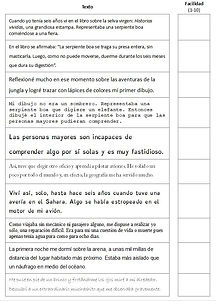Legible typographies

In order to be able to develop teaching materials better adapted to the special needs of a significant part of the student body (and from which all students will really benefit) a test has been carried out to check the degree of legibility of different typographic fonts.
To this end, firstly, different recommended fonts have been selected for the adaptations of teaching materials for students with dyslexia and reading comprehension difficulties.
Afterwards, different font sizes and line spacing have been established and, finally, other non-recommended fonts have been chosen along with some of obvious difficulty in verifying the validity of the answers.
The text chosen for the test has been the Spanish translation of The Little Prince, to which small changes have been made to adapt the length of the texts.
The typefaces and fonts tested:
1. Calibri 12, normal line spacing
2. Calibri 12, line spacing 1.5
3. Calibri 14, line spacing 1.5
4. Courier New 12, normal line spacing
5. Dyslexie 12, line spacing 1.5
6. Adobe Caslon Pro 12, Normal Line Spacing
7. Dyslexie 11, Normal Line Spacing
8. Times New Roman 12, normal line spacing
9. Arial 12, line spacing 1.5
10. Bradley Hand ITC 12, Normal Line Spacing

To carry out the analysis we have had 72 tests that have been filtered according to the score received by fonts 4, (8) and 10, since they are part of the discouraged fonts. These fonts, and especially number 10, Bradley Hand ITC, have been chosen to determine the students' understanding of the task and the consequent validity of the data collected from the study.
Results and Conclusion
On the one hand, it is confirmed that the typographic fonts commonly recommended to facilitate reading for students with dyslexia and reading comprehension problems, such as Calibri, Arial or Dyslexie, are the best valued.
On the other hand, the preference for the Dyslexie typeface is called into question, since, even though they receive very high scores (average of 9/10), some students with dyslexia and difficulty in reading comprehension have shown difficulties in reading with this typeface.
For this reason, the conclusion of this test is that the use of Calibri or Arial fonts is recommended for paragraphs and long texts, while Dyslexie typeface could be used in standalone sentences and titles or epigraphs to take advantage of its aesthetic value.
Dyslexie Regular
Dyslexie Regular
Dyslexie Regular
Dyslexie Regular
Dyslexie Regular
Calibri
Calibri
Calibri
Calibri
Calibri
